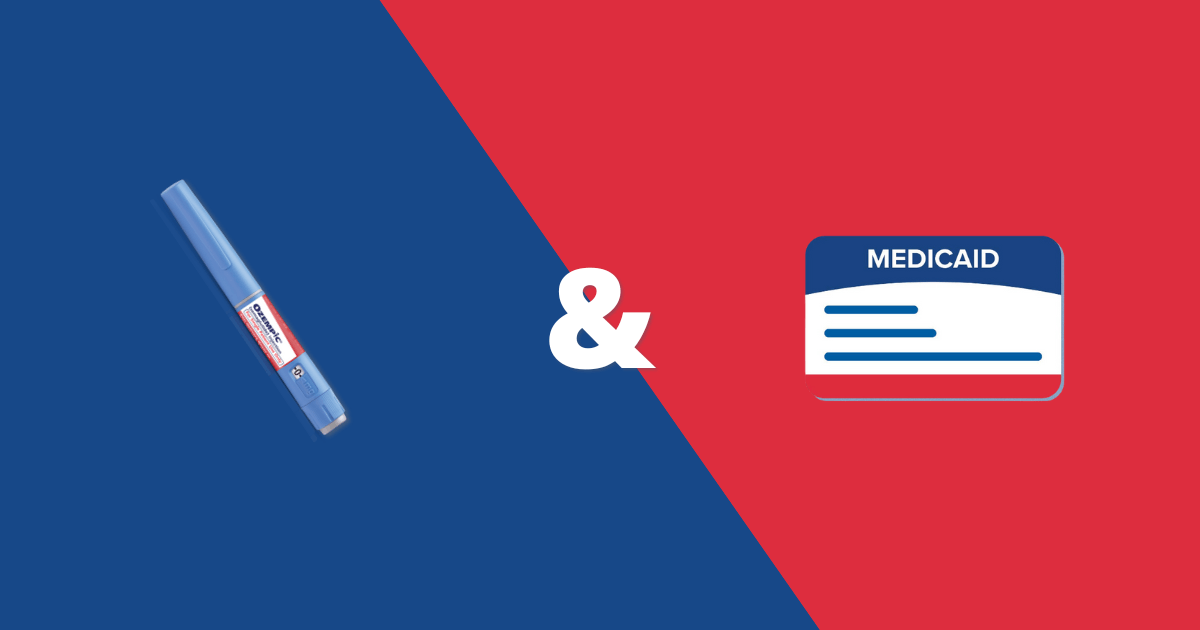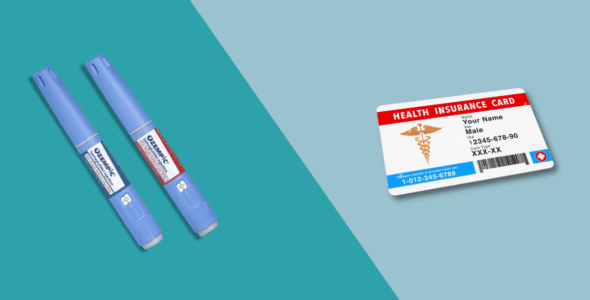Does Medicaid cover Ozempic?
Key highlights
- Eligibility criteria for Medicaid coverage for Ozempic varies by state.
- While Ozempic is generally covered as a treatment for type 2 diabetes by most Medicaid plans under certain conditions, it is generally not covered for weight loss alone.
- There are other weight loss medications such as Wegovy and Saxenda that may be covered by Medicaid, depending on which state you live in.
- There are other options to save money without Medicaid coverage.
Ozempic (semaglutide) is a popular GLP-1 (glucagon-like peptide-1) injectable medication approved by the FDA (U.S. Food and Drug Administration) for the treatment of type 2 diabetes. GLP-1 medications effectively stimulate insulin production and lower blood sugar levels. While weight loss is a common side effect, Ozempic is not approved for chronic weight loss management.
Ozempic can cost around $1,000 per month without insurance. However, patients can save on this medication by using discount cards, manufacturer savings cards, and patient assistance programs.
For people with Medicaid coverage, Ozempic can be covered in some cases if prescribed for its approved use, type 2 diabetes. If you are taking Ozempic for weight loss only, and not for diabetes, Medicaid will not provide coverage in most states.
Prescription drug coverage for Medicaid varies by state. Learn more about Medicaid coverage for Ozempic and whether you are eligible for reimbursement.
How much does Ozempic cost?
The list price for all dosage strengths of Ozempic without insurance coverage is $968.52 for a 1 month’s supply according to Novo Nordisk. The price remains the same regardless of whether you are taking it for type 2 diabetes or weight loss.
You can save on Ozempic by using discount coupons, manufacturer savings cards, or enrolling in the patient assistance program.
With insurance, including Medicaid, your out-of-pocket costs will be based on factors like your specific prescription drug coverage, copay, and deductible.
Does Medicaid cover Ozempic?
Medicaid coverage for Ozempic varies by state. While Ozempic is generally covered as a treatment for type 2 diabetes by most states’ Medicaid programs, several factors influence coverage including whether Ozempic is listed as a “preferred drug” in your state.
You can find out whether your Medicaid program covers Ozempic by visiting the medication’s website or checking your state’s Medicaid formulary or preferred drug list. Most state Medicaid programs list Ozempic as a preferred or nonpreferred medication on their formularies. For example, Ozempic is listed as a preferred drug in Texas, but it is listed as a nonpreferred drug in Wyoming and Arizona. To find your state’s preferred drug list (PDL), simply type into Google Search “your state + preferred drug list”, for example, “Arizona preferred drug list”.
It is important to note that Medicaid will generally provide coverage for Ozempic if prescribed for its FDA-approved use, type 2 diabetes, and most likely will not provide coverage if the medication is used for weight loss alone. You should contact your state’s Medicaid agency to find out if Ozempic is covered for weight loss if you do not have type 2 diabetes.
If Ozempic is listed on the state’s formulary without requiring prior authorization, you could get the medication through Medicaid regardless of the diagnosis. If Ozempic isn’t listed on the state’s formulary or requires prior authorization, it would most likely only be potentially covered for individuals with type 2 diabetes.
Does Medicaid cover Ozempic for weight loss?
In most states, Medicaid does not generally cover Ozempic for weight loss because it is approved for type 2 diabetes. Although Ozempic is commonly prescribed off-label for weight loss, it is not FDA-approved for chronic weight loss management.
Under the Medicaid Drug Rebate Program, Medicaid programs are required to cover nearly all of a participating manufacturer’s FDA-approved drugs for medically accepted uses. However, weight loss drugs can be excluded from Medicaid coverage.
While a survey found that several states were considering adding Medicaid coverage of weight loss medications, studies show that only a limited number of states cover weight loss medications in Medicaid, with some states only covering the drugs for severe obesity, with comorbidity, or other conditions.
Some state Medicaid programs cover weight loss medications like Wegovy (same active ingredient as Ozempic, semaglutide) and Saxenda (liraglutide), which are FDA-approved for chronic weight management.
What factors influence Medicaid coverage for Ozempic?
Currently, most states do not cover Ozempic as a weight loss drug. Even if you are prescribed Ozempic for type 2 diabetes, certain conditions must be met to get Medicaid coverage. Some states may cover Ozempic if it’s on their preferred drug list, with certain clinical criteria such as:
- A diagnosis of type 2 diabetes
- Clinical evidence of step therapy with another lower-cost type 2 medication such as metformin
- Documented A1C levels (lab value indicating blood sugar levels)
If Ozempic isn’t on your Medicaid plan’s formulary and is considered a nonpreferred drug, you may still be able to obtain Medicaid coverage if you meet additional criteria. For example, in most states, you will be required to try and fail at least 2 or 3 lower-cost medications for type 2 diabetes for a minimum number of days before you become eligible for Ozempic coverage.
The requirements vary by state so you must check the requirements with your state Medicaid program.
Some states cover weight loss drugs such as Wegovy so if you live in a state where Wegovy is covered, and are considering using semaglutide injection for weight loss, consider speaking to your doctor about Wegovy.
Does Medicaid cover Wegovy?
Wegovy is another GLP-1 medication manufactured by Novo Nordisk, with the same active ingredient as Ozempic, semaglutide, and is specifically approved for weight loss management. Wegovy has a list price of $1,349.02 per month, according to the manufacturer’s website.
Unlike Ozempic, Wegovy is FDA-approved for chronic weight management in adults with obesity or overweight and is covered by some states’ Medicaid programs. Currently, at least 10 states have listed Wegovy as a preferred drug in their formulary:
- California
- Delaware
- Massachusetts
- Michigan
- Minnesota
- Mississippi
- New Hampshire
- Pennsylvania
- Rhode Island
- Virginia
Some states may require prior authorization for Wegovy or may have certain quantity or coverage limitations.
Individuals seeking Wegovy for weight loss should check with their state Medicaid program for coverage details to determine eligibility.
Does Medicaid cover Zepbound or Mounjaro?
Zepbound is a popular weight loss drug that is manufactured by Eli Lilly. It has a list price of $1,059.87 for a 1 month supply.
It has the same active ingredient as Mounjaro, tirzepatide, which is FDA-approved for the treatment of type 2 diabetes. Mounjaro has a list price of $1,069.08.
Check your state Medicaid program’s formulary to determine if Mounjaro is covered. Mounjaro is listed as nonpreferred on various state Medicaid formularies, including Arizona, Texas, and Tennessee.
Currently, Zepbound is not listed on any state Medicaid program’s formulary but this may change in the future. You can continuously monitor your Medicaid program’s formulary for updated information. You can try going to Zepbound’s coverage and savings website, click “I have insurance through Medicaid.” and use the locator to find your state program’s drug formulary.
In some cases, state Medicaid programs may cover medications that are not listed on their formularies with potentially higher copays and/or prior authorization requirements. You can try contacting your state agency to determine if coverage for Zepbound is currently possible. If you can’t obtain coverage, speak with your healthcare provider about appealing the decision.
Like with Ozempic, some Medicaid programs require prior authorization before covering Zepbound or Mounjaro. Enrollees may also be subject to the similar factors that influence Medicaid coverage with Ozempic.
How to get Ozempic with Medicaid
Follow these steps to obtain coverage for Ozempic through Medicaid:
- Obtain proof of a diagnosis of type 2 diabetes from your healthcare provider.
- Check if Ozempic is listed as a preferred or nonpreferred drug on your state’s Medicaid plan.
- If Ozempic is listed as a preferred drug, check if any other clinical criteria is required, such as step therapy with metformin and/or an A1C test result, or prior authorization. You should also check if your plan requires prior authorization. If prior authorization is not needed, you can get a prescription for Ozempic from your healthcare provider. If prior authorization is required, your healthcare provider will need to submit the request to your plan first.
- If Ozempic is not listed on your state’s formulary, you may be required to try and fail at least two other preferred type 2 diabetes drugs first. You can check with your plan to determine if this is the case, and if so, how many alternative type 2 diabetes drugs you are required to try first, and if they need to be specific drugs (e.g. metformin, Victoza, Trulicity, etc).
- Comply with any nonpreferred drug and prior authorization requirements for your state’s plan. After completing the required steps, you can get a prescription for Ozempic from your provider.
It is important to take into consideration that all of these steps are dependent on your state’s requirements and it is highly recommended to check with your state’s Medicaid plan if you are unsure of the requirements and process.
How much does Ozempic cost with Medicaid?
The cost of Ozempic with Medicaid coverage can vary depending on several factors, including whether Ozempic is on the state’s formulary and other factors. Generally, Medicaid enrollees pay less than an $8 copay for medications on the condition that the state’s coverage requirements are met.
Other factors that influence the copay amount include whether the drug is listed on the formulary as a preferred or nonpreferred drug and whether or not the drug requires prior authorization. In some cases, drug copays can be waived if the patient is below a certain age or if the drug falls into a specific category (e.g. family planning or smoking cessation).
While it isn’t possible to estimate how much Ozempic with Medicaid will cost in your specific state, we can provide examples of Medicaid prescription drug copays from a few states (please note that the copay may vary by plan):
- New York
- Non-preferred brand name drugs: $3 copay
- Preferred brand name drugs, generic drugs, and some other drugs: $1 copay
- Indiana
- Between $3 and $10 copay, depending on whether the drug is generic or brand name and the specific Medicaid plan
- Vermont
- $1 for drugs with Medicaid reimbursement that cost less than $30
- $2 for drugs with Medicaid reimbursement that cost $30 or more but cost less than $50
- $3 for drugs with Medicaid reimbursement that cost more than $50
As demonstrated by the above examples, the copay can vary significantly by state so it is recommended to check with your state agency to confirm how much you will be required to pay.
How to save on Ozempic without Medicaid
If you don’t have Medicaid coverage for Ozempic and are looking for other ways to save money on this medication, you can consider these options:
- Ozempic Savings Card: Novo Nordisk offers a Savings Card that can significantly reduce your out-of-pocket costs, if eligible. If you have commercial health insurance, you could pay as low as $25 per month for Ozempic.
- NovoCare Pharmacy: Uninsured patients or those without insurance coverage for Ozempic can purchase the brand-name medication directly through NovoCare Pharmacy for $499 per month.
- Use discount cards: Websites like SingleCare and GoodRx offer prescription discount cards that can lower the price of prescription medications.
- Compare pharmacy prices: Prices for prescription drugs like Ozempic can vary between pharmacies. Compare prices between pharmacies to find the best possible deal.
- Alternative medications: Discuss alternative medications with your health care provider. Your doctor might be able to provide samples or suggest other FDA-approved GLP-1 agonists that could be more affordable.
- 90-day supply: Some mail-order pharmacies provide discounts when purchasing a 90-day supply at a time.
- Patient assistance programs: Novo Nordisk’s patient assistance program, NovoCare, offers free Ozempic to eligible patients with type 2 diabetes.
- HSA or FSA: Find out if you can use funds in your health savings account (HSA) or flexible spending account (FSA) to pay for your medications.
These tips can help you save money on Ozempic, whether you are using it for type 2 diabetes or weight loss.
Bottom line
Ozempic is generally covered by most Medicaid plans with certain conditions if it is prescribed for its approved use, type 2 diabetes, and is generally not covered if prescribed for weight loss alone. Other weight loss medications such as Wegovy or Saxenda may be covered in your state.
Medicaid coverage varies by state so it is recommended to check with your state agency on the factors that influence coverage in your state.
If your plan does not cover Ozempic, there are several other ways to save money including prescription discount cards, manufacturer savings cards, and patient assistance programs.














